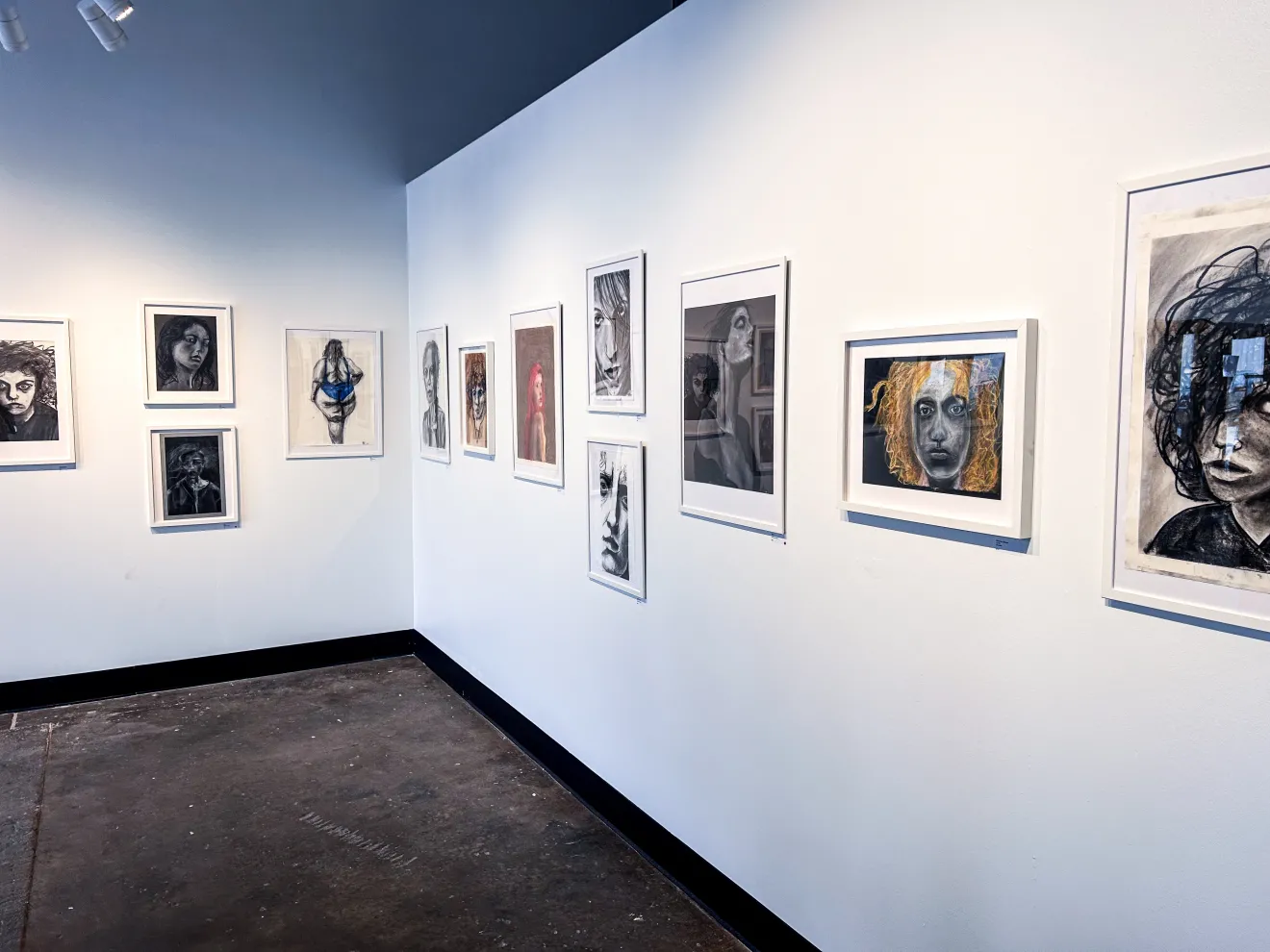Evocative: A Neurodivergent Artist’s Unfiltered Return to the Canvas
- News
- Events

How Neva Bothager found healing and visibility through charcoal and connection.
Dark swaths of charcoal sweep across paper, showing heavy lines of contrast and pops of color that lift the subject from the frame. The gallery walls echo untold stories, each piece drawing the viewer into a unique and personal experience. Visitors pause, transfixed by the stories so evident in the portraiture. Neva Bothager, a neurodivergent creative, has rediscovered her artistic voice after years of silence. Inspired by her lived experience and the world around her, Bothager’s first gallery, Evocative, highlights the human figure, displaying expressions and positions meant to “make someone stop and face whatever that thought may be.”
Educated as a sculptor in Texas, Bothager only recently began her exploration of 2D art. Her return to creative expression began with several different mediums, including gouache, acrylic, and watercolor pencils; however, nothing felt right. Then came charcoal. “I picked it up and just said, ‘Oh, I forgot. I love you.’” Having studied fine arts during her BFA in sculpture, Bothager had some familiarity with the medium and soon progressed to combining it with colored chalks and ink. She favors “the sculptural qualities of charcoal to push and pull the figure from the page, while using pan pastels and inks to guide the viewer on a journey through the landscape of humanity.”
Bothager’s reentry into the art world was sparked by a staff member at Boundless who saw her drawings and said, “You need to be seen.” Through them, Bothager connected with another Boundless staff member, Angela Bellin, who advocated for her and pulled her into the gallery scene. Through Bellin, Bothager connected with The Awesome Gallery, a space solely dedicated to showcasing the work of neurodivergent artists. In just six months, she went from tentative exploration to exhibitions and sales. Bothager shared, “I couldn’t even price my work. When someone bought a piece, I was like… wait, you want that?”
Bothager shared that she is “not always sure” how a piece comes to be. She elaborated that her process is rooted in photo references and emotional resonance; however, “sometimes I look until I see something that has to be seen.” She refers to this instinct as a sort of political endeavor in which “you kind of have to get down and see where the political is.” There is no formula. Her creative process identifies a visual truth that matches her felt reality and demands to be seen. For Bothager, “it’s not really about the relationship between me and the viewer. It’s about the viewer’s relationship with the art.” While her work reflects her inner world, passions, and beliefs, she does not wish to impose a perspective on her viewers; rather, she encourages them to form their own connection with the subject matter.
Diagnosed with ADHD, anxiety, and depression, all of which were found much later in life, Bothager found that each diagnosis came not with relief, but grief. “I went through the whole process; anger, mourning who I could’ve been.” She was in such a bad state that she was unable to work, and her health and home were showing the effects of this depression. Art became a channel to process what words couldn’t hold. According Bellin, who is an Economic Connections (E-Conn) Specialist at Boundless, “She needed to create. She needed to connect with other artists. She has more evidence of success now, instead of evidence of failure. That has been a game changer for her.”
For Bothager, art has been a way to return to herself, and finding confidence in her work has given her hope for a future of connection. In her words, “The work is coming out of me. It shows what I see, what I’ve lived. That’s why I want people to see it.”
Anxiety, depression, body image. These aren’t just topics; they are textures in Bothager’s work. Her collection, Evocative, invokes feelings of discomfort, reflection, and confrontation. She touches on topics often sanitized, specifically the female experience as shared through the lens of her education in women’s studies and the feminist art movement. Bothager’s influences form an eclectic mix. From a young age, she was captivated by the work of Vincent Van Gogh and his use of emotional intensity. During her years of sculptural work, she found inspiration through Auguste Rodin, who captured “emotion in motion,” similar to what we find in Van Gogh’s paintings but in a three-dimensional format. More recently, Bothager has found direction in her 2D work from the influence of Lucian Freud and the gestural qualities of his art depicting unapologetic bodies. She shared, “Even with all the body positivity, sometimes it just doesn’t feel good,” about the female experience. The feminine nude is a common occurrence in Bothager’s collection as she uses her art to highlight diversity and the beauty of larger bodies.
Bothager’s college-aged daughters speak with pride and awe in reference to their mother. Both find her work “mesmerizing,” with each feeling inspired to pursue their own creative work more boldly. The girls recall growing up around her sculptures, but never seeing their mother prioritize her own talent. They shared, “It’s amazing to see her happier, healthier… she’s showing us you can start again.”
Bothager is focused on the present, but not without ambition. She hopes to participate in more galleries, continue building an online presence, and find her art tribe. Her advice to up-and-coming artists: go to shows, find other artists, be part of the community. She commented, “I’m always looking for my tribe.”
Bothager’s story reframes what it means to pursue your passions. There is no timeline for creativity or self-discovery. The beauty of a body, of a mind creating on its own terms, is boundless. At the end of the day, she said, “You put the armature up there, and then you figure out how to do it.”
To view Bothager’s work, visit The Awesome Gallery from August 2, 2025, to August 30, 2025. The gallery is located at 3400 Southwest Blvd, Grove City, OH 43123. To learn more about the E-Conn program, which connected Bothager with the tools to return to the canvas, submit a referral here.





